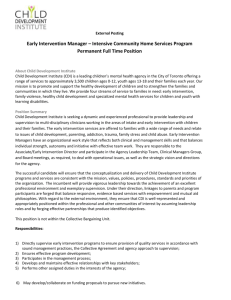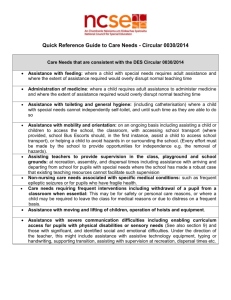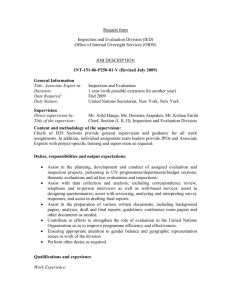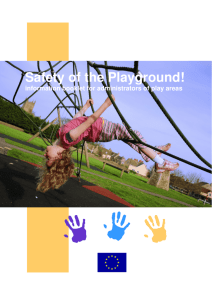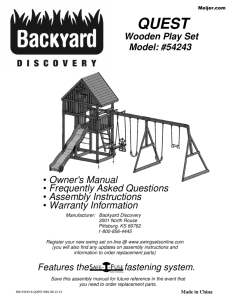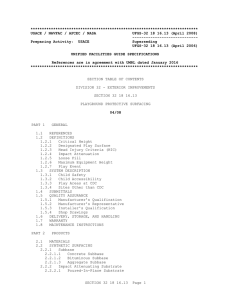Playgrounds and play equipment
advertisement
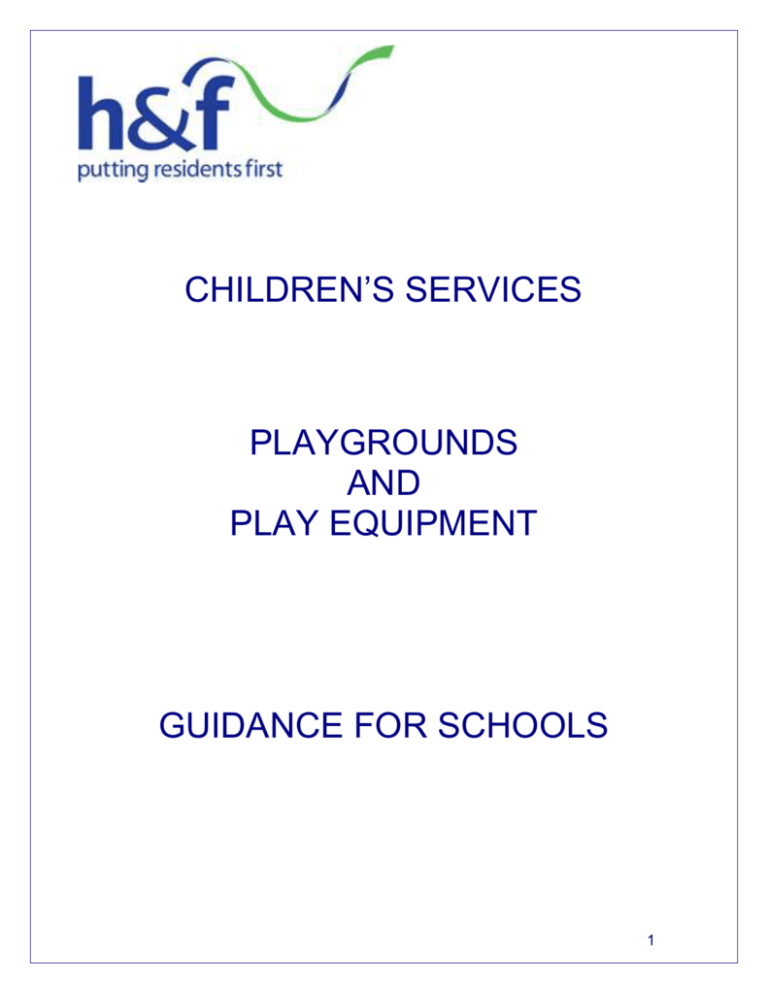
CHILDREN’S SERVICES PLAYGROUNDS AND PLAY EQUIPMENT GUIDANCE FOR SCHOOLS 1 LEGISLATION Health and Safety at Work etc Act 1974 Occupiers Liability Acts 1957/1984 Disability Discrimination Act 1995 Management of Health and Safety at Work Regulations 1999 PLAY EQUIPMENT STANDARDS BS EN 1176: Playground Equipment (11 Parts) BS EN 1177: Impact Absorbing Playground Surfacing BS EN 15312: Free access multi-sports equipment The European Standards are not retrospective or a legal requirement but they represent good practice. However, it does not mean that older facilities, constructed to previous standards are no longer safe. WHAT YOU NEED TO DO Ensure that playgrounds and play equipment are appropriately sited and designed Ensure that new equipment/safety surfaces are designed and installed to the appropriate standards Ensure that where any new equipment/safety surface is installed, appropriate certification and documentation is obtained Ensure that risks associated with play activities are assessed and that control measures are adopted Ensure that there is appropriate levels of supervision during play periods Ensure that all play grounds and play equipment is regularly inspected and maintained INTRODUCTION Play is an essential part of every child’s life. It provides the mechanism for children to explore the world around them and the medium through which skills are developed and practiced. Risk taking and challenge have an especially important role in children’s play and development. Well designed, supervised and maintained play grounds and play equipment provides an additional stimulus for children and gives them an opportunity to improve their motor skills and test their physical abilities in a controlled and supervised environment. 2 DESIGN CONSIDERATIONS Designing for play is an ongoing process. Successful play spaces are not simply ordered from a catalogue, put in the ground and left. They require careful thought and planning, continuing care and maintenance. When new play equipment is to be purchased or playgrounds refurbished, an appropriate procurement processes should be adopted to ensure compliance with appropriate legislation and good practice standards. Involvement of a professional contractor/designer experienced in designing play spaces is critical. When procuring equipment and/or services, establishments must undertaken adequate checks to ensure the competency of those to be hired. Further information can be found in the Play England document: Making Space for Play. EQUIPMENT SELECTION Children really enjoy using play equipment and all the challenges it offers. Playground equipment is particularly good at providing for more active play, including movement such as climbing, swinging, sliding and rotating. All new equipment should comply with British Standards European Norm specification and guidance for play equipment. Equipment manufacturers can advise on the best types of equipment for different play experiences. The Association of Play Industries (API) is the trade association of equipment suppliers and manufacturers. Members of the API have been checked for reliability and offer a wide variety of types of products, as well as design advice. SAFETY SURFACING Impact absorbent surfacing (safety surfacing) can be provided in a variety of materials. Where used the depth of material must comply with the regulations relating to the critical fall height, and this must be considered in relation to the maximum height of the equipment. Although impact absorbing surfaces cannot prevent accidents they may reduce the level of injury. The type of surface under play equipment is a risk factor which must be considered when providing play equipment. 3 A surface with test requirements is not required for low level play equipment items, less than 600mm fall height, that do not introduce a ‘forced movement’ on the user. Items with higher fall heights or those producing ‘forced movement’ still require a tested surface to reduce life threatening head injuries to a child. The extent of surfacing around static equipment is dependent on the fall height of the equipment. For example, where the fall height is 2.0 metres surfacing should extend 1.83 metres. A different calculation applies for moving equipment and advice should be sought from the independent competent person carrying out annual inspection and maintenance. INSTALLATION DOCUMENTATION Equipment manufacturers/suppliers must submit documentary evidence of compliance with BS EN 1176 and BS EN 1177. Where equipment is unable to meet a standard, an explanation of acceptability or evidence of third party testing by a recognised body or a risk assessment should be provided. Appropriate test certificates should be obtained by the school indicating that the surfacing meets the impact absorbency requirements for the equipment to be used. The installer should provide written confirmation that the equipment and surfacing have been installed to the manufacturer’s instructions and to the relevant standard where appropriate Where considered necessary, a post-installation inspection, including indicative surfacing tests, should be carried out by RoSPA or other appropriate body. PLAYGROUND FURNITURE Appropriate ancillary items, such as gates, fences, litter bins and seating if provided should be constructed and installed to apply to the requirements of BS EN 1176. Cluttered play areas cause supervisory and accident problems for schools and the installation of any ancillary equipment should be an integral part of an overall plan. Ancillary equipment should not restrict the statutory recommended open play areas or their safety run-off zones. Where practicable, the space beyond playgrounds and their safe run-off zones should be considered for furniture and equipment locations. 4 ANCILLARY PLAY EQUIPMENT In some play ground environments, establishments may have additional features such as sand pits or skateboarding areas. Further advice and guidance on these can be found on the Royal Society for the Prevention of Accidents website (see below). WEED CONTROL/USE OF CHEMICALS AND PESTICIDES This might be necessary to reduce trip hazards and prevent damage to surfaces. Any weed control should be carried where possible at the beginning of the school holidays. Springtime would be the time of year when this would be likely to be most effective but if weed growth makes the area hazardous further control may be necessary. Spraying should only be undertaken by the site manager if he/she has been adequately trained and certificated. RISK ASSESSMENT The design, installation, use and maintenance of playgrounds and equipment should be subject to a risk assessment. This should identify hazards and the necessary measures necessary to control risk to a reasonably practicable level. Typical hazards to consider will be: Slips, trips and falls associated with equipment use Use of equipment by children with special needs Damaged or faulty equipment and safety surface Inadequate or poor levels of supervision Inclement weather Older equipment/use of second-hand equipment Poor maintenance and inspection regimes Use of equipment by inappropriate age groups Use of equipment by large numbers of children Children wearing inappropriate clothing SUPERVISION The safe usage of equipment provided for the physical development of pupils relies on adequate arrangements for supervision and control being established and followed within the school. Supervising staff must be familiar with the equipment, the rules for its use and the levels of response which may reasonably be expected from children in its use. 5 The number of persons required to supervise should be determined by the risk assessment. As a general rule, the younger the children the greater the level of supervision required. The more hazardous the equipment the greater the level of supervision required. Generally the risk of injury increases with the increasing fall height of the equipment Equipment requiring close supervision should only be provided if it is possible to provide adequate supervision for it on a regular basis. This may have significant staffing implications. An example of equipment requiring close supervision is overhead hand ladders or “monkey bars”. Pupils must only be allowed to use the equipment when playground supervision is provided in the area in which the equipment is located. Pupils using the equipment must wear suitable footwear and clothing. Pupils should be shown the correct usage of the equipment. UNAUTHORISED USE It is possible that parents bringing their children to school or waiting to collect their children in the afternoons will allow younger brothers and sisters to play on the equipment although it is not suitable for their age group. If an accident occurs a claim will be likely. The use of the equipment by children other than those who attend the school should be strongly discouraged. Sign(s) should be displayed in a prominent position near the play equipment stating that it is provided solely for the use of the children who attend the school under the supervision of their teachers. MAINTENANCE BS EN 1176-1 requires that the equipment and its components should be inspected and maintained according to the manufacturer’s instructions at a frequency not less that that stated by the manufacturer. Daily visual inspection by supervising staff prior to use should include looking for evidence of vandalism/damage to equipment or surfaces. The area around equipment should also be checked to ensure it is clear of glass, animal faeces, litter etc. Weekly Inspection by a nominated person should be a checklist provided by the equipment supplier or the body undertaking the annual inspection. It should be carried out by a competent person on the school staff who has received appropriate training. 6 The annual inspection should be undertaken at intervals, not exceeding 12 months. It should be carried out by an independent and competent specialist. It should be carried out in strict accordance with the manufacturer’s instructions. RECORDS Inspection record sheets and records of work actioned as a result of them should be kept for the life of the equipment. They should include date the work was carried out and the reasons for it. Records of annual inspections by the play equipment inspector should be kept during the life of the equipment as they will be required if a claim is made following an accident. REPAIRS Faults identified during the inspection should be rectified immediately if they are hazardous. If this is not possible then the equipment should be taken out of use until such time as it has been made safe. Hazardous equipment which is beyond economic repair must be taken out of use immediately, appropriately signed and be removed from the site and safely disposed of as soon as possible. When it is necessary to remove equipment from the site the ground underneath must be made good afterwards. When repairs are required, always use the manufacturer’s correct replacement parts or provide parts of equivalent or better quality. If the original manufacturer no longer exists, obtain advice on suitable replacement parts from a play equipment inspector. FURTHER INFORMATION The Children’s Play Information Service: www.ncb.org.uk/cpis Association of Play Industries http://www.api-play.org Play England: www.playengland.org.uk Royal Society for the Prevention of Accidents: www.rospa.com/leisuresafety/adviceandinformation/playsafety/default.aspx 7
